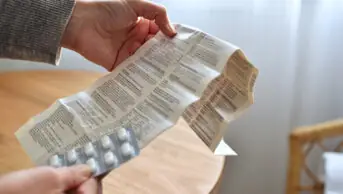
Courtesy of Raj Patel
The falsified medicines directive (FMD) — an initiative to limit the movement of medicines that can contain toxic ingredients, or ingredients in the wrong dosage, by barcode-tracking medicine packs from manufacturer to dispensary — comes into place on 9 February 2019. With just a year to go, The Pharmaceutical Journal caught up with Raj Patel, chair of the UK FMD Working Group for Community Pharmacy, and board member of SecurMed UK, the organisation tasked with implementing the medicines verification system in the UK.
Our survey of members of the Royal Pharmaceutical Society in 2017 suggested that most (68%) pharmacists support the FMD in principle, but 72% still do not fully understand how FMD would affect their work — is this consistent with what you’re hearing?
We’re hearing from a similar proportion of pharmacists who have not heard of, or not fully understood, what FMD is all about. But I have to say, we’ve also heard of a big group of pharmacists who don’t see the relevance of FMD, and liken using FMD to catch falsified medicines within the supply chain to using a sledgehammer to crack a nut. So, there’s feeling on both sides. A lot of work is needed to ensure pharmacists are aware of FMD, what it entails, and what is required of them.
What are the main concerns coming from pharmacists who are aware of FMD?
The issue of implementation is extremely important to them, and the question of who is going to pay for it. Once pharmacists know what FMD is all about, and once they know that this has to done — there is no get-out clause with this — the penny will have to drop, and they will have to ask, what do I need to do? When do I need to do it by? And how much is it going to cost me? In terms of cost, it’s not just a matter of integrating the software into the patient medication record (PMR) system, and the scanners, and other hardware and software; there’s a whole host of extra costs to consider, such as training, and how the dispensing process is going to run within the pharmacy. We’re telling pharmacists about these challenges and we’re saying: “Guys, don’t wake up at the last minute — this is something that you need to prepare for.” It’s been at least two years since we’ve been saying that this is going to be coming, and now we’re less than a year away until the directive comes into place. This will happen in February 2019, whether we’re ready or not. We’ve been told by the Department of Health and Social Care (DHSC) and the Medicines and Healthcare products Regulatory Agency (MHRA) that the date will not be changed.
Are the UK Government and the MHRA doing enough to address pharmacists’ concerns and keep them in the loop?
First, there’s the issue of the EU legislation. The legislation leaves very little manoeuvrability by any member state, let alone the UK. The delegated regulation is there to stay, to be met for February 2019. During our meetings, we’ve been confident and comfortable that the messages we’re getting are dropping on pharmacists, and that pharmacists are now in the process of thinking about what’s going to happen during the next 12 months, and the implementation challenges that their pharmacy may have. Yes, the MHRA and DHSC, in all fairness, are trying to help, but their hands are tied.
Secondly, there’s also a requirement for the associations — the National Pharmacy Association (NPA), the Royal Pharmaceutical Society (RPS) and the Company Chemists’ Association (CCA) — to help pharmacists get through this challenge. But ultimately it will be the pharmacists who have to implement and get on with it. There will be processes in place, and there will be sanctions in place if they don’t adhere to the processes. Information on this will be out in the consultation that the MHRA will publish during the next couple of months.
You’re part of SecurMed UK and the UK FMD working group for community pharmacy — what do these organisations do and how did you get involved?
I represented the NPA at the Pharmaceutical Group of the European Union (PGEU), and, by our association with the PGEU, I was president of the group during 2017. Over the last three or four years, while FMD had been brewing in the background, there was a requirement within the UK for the formation of a national medicines verification organisation (NMVO). We formed this with the other constituent members, of which pharmacy was one, and at that time the NPA, along with the CCA, become representatives for pharmacy, and SecurMed UK was formed.
The FMD working group, which I chair, seeks to work with the MHRA and DHSC to highlight the challenges, and implementation costs, of this directive. But let me clarify, we’re only highlighting the costs. We’re not negotiating them. Negotiation will be done by the negotiating bodies within the UK.
What does the FMD working group discuss during its meetings with the DH and the MHRA? How are things moving along?
The working group represents all sectors of community pharmacy — from contractors through to the negotiating bodies — and the MHRA and DH are also in attendance. We discuss everything from the implementation, right up to enforcement. Together, we have formed a paper, ‘The way forward to FMD in community pharmacy’, which is now available on the FMD Source website for anyone to read, and that explains FMD from A–Z. It discusses all the complications, the challenges, what the delegated regulation says, its interpretation, and safety issues; the whole gamut of things that are involved can be found in this paper.
The FMD will be rolled out across Europe — has pharmacy seen an initiative of this scale before?
The simple answer is no. This is a huge project. Imagine the 500 million people right across Europe — a good majority of those will be visiting pharmacies. In the UK alone we’ve got nearly two billion packs of products a year passing through pharmacies that are going to require scanning. If you then extrapolate up, you can imagine just how many billions of packs will be processed in this manner across Europe. Then imagine the one European hub that is connected up to many national hubs, and those national hubs are then going to go out to pharmacies; now you understand the extent of the project. Adding complications to this is the fact that there will be different regulations for pharmacy in different member states, and working out how these will be implemented adds more complexity to the whole process.
How are other countries across Europe faring on their road to implementation?
Some already have their own tracking systems, like Belgium, for example. They will find it easier. But the majority don’t and they are facing the same challenges and pressures that we are. Other countries are going through the same process, and they are all at very different stages in their implementation. Some have already got an NMVO set up. They’re forging ahead with implementation, but some have yet to do that. We still have less than 12 months to go, and there are challenges for many member states.
Welsh pharmacies already use handheld devices for scanning 2D-barcoded prescriptions — will Wales be better prepared for FMD than the rest of the UK?
There are scanners already in most of the UK for scanning prescriptions that come in, but it’s the type of scanner that’s important. The barcode to fulfil FMD will be a 2D barcode. The barcode on the prescriptions we give in most of the UK is a 1D barcode, and the 1D barcode scanner will read only those 1D barcodes. We have to change those scanners around to make sure that FMD functions. But it’s not just the scanners that are important; there’s a whole load of other things. For a system to work efficiently within pharmacy you have to have an integrated system with a PMR supplier, so the PMR supplier needs to be brought into FMD implementation. There needs to be a bridging software that ensures that messages are being sent to the national hub, which runs concurrently with the dispensing process. All of these things need to be ironed out, so it’s not just a matter of saying, “oh, is the scanner okay?”. The scanner is important, but hardware is only part of the whole story. There’s a lot of other stuff that needs to go on — training, implementation, and considering the way our dispensaries are run.
It’s not long before FMD becomes a reality — do you think UK pharmacy will be ready by February 2019, and will those who are not ready be penalised?
I wish I had a crystal ball! But I have to say that if you consider the work and challenge ahead of us, it is going to be extremely difficult for us to reach that deadline. I think that a major reason for that has been Brexit. Because of Brexit, there has been a huge amount of uncertainty, so, for example, there’s a seven-week gap between implementation of the FMD according to the delegated regulations, and the UK coming out of Europe. And we don’t know what’s going to happen beyond those seven weeks. So once Brexit hits in March 2019, we don’t know whether the government will say “okay, there’s no need to do this”, or “we are going to do this but in a different way”. So there is uncertainty over all of this. When you’re talking to pharmacies, what are they to think? Are they going to be implementing FMD for only seven weeks? And then what’s going to happen beyond that? It is the responsibility of the MHRA and the DHSC to let us know what is going to happen beyond that time. How are we to manage our pharmacies with this uncertainty? This is where the UK FMD working group has come in, and we are trying to talk with the MHRA and DHSC to work out, realistically, what is going to happen beyond Brexit.
There will be transitional phase for pharmacies in implementing FMD. This is going to be highlighted in the MHRA’s consultation document, coming soon, which will explain what the recourses are and who the inspectors are going to be. So we will know a lot more after that point.
The FMD primarily aims to prevent the spread of fake medicines, but are there any other added benefits for pharmacists and patients?
Yes, I think there are. The product codes and batch numbers will be contained within the barcodes, and that will give us additional benefits in the form of accuracy checks when we’re dispensing any product. When we scan a product, we will know that it is the product we want to dispense, and not something different — a good thing for patient safety.
You may also be interested in

Medicines commission calls for greater clarity on risk of suicidal behaviour from antidepressants

Patient safety commissioner pushes government on valproate redress almost two years after report
